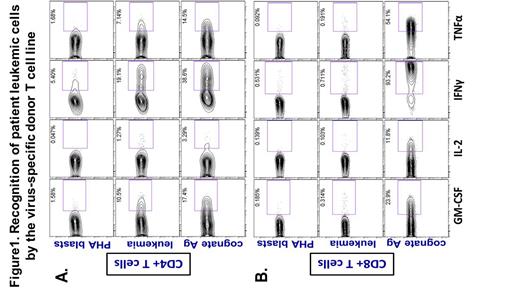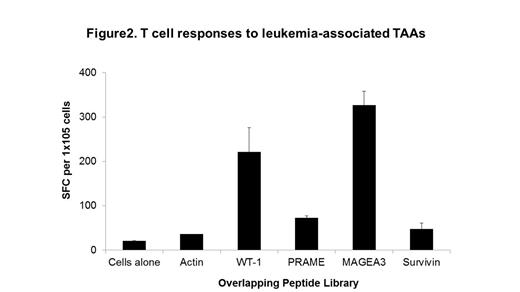Abstract
Refractory acute lymphoblastic leukemia (ALL) remains a disease with poor prognosis, and a small percentage of patients that undergo allogeneic stem cell transplantation will respond. Following allogeneic transplant, donor T-cells may cause graft-versus-host (GVH) alloreactions but also confer immunity to viruses and exert a graft-versus-leukemia (GVL) effect contributing to maintenance of minimal residual disease and cure of leukemia. Control of viral disease can be enhanced by infusion of ex-vivo expanded virus-specific T-cells. Since some malignancies such as Epstein-Barr virus (EBV)-driven lymphoproliferative diseases can express viral antigens they can be successfully eradicated by EBV specific CTL. However cross-reactivity between virus-specific T cells and non-viral hematological malignancies has not been described.
Here we report for the first time an apparent GVL effect against ALL from ex-vivo expanded multivirus specific CTL. A 12-year-old boy with refractory ALL received a haploidentical transplant from his mother. As prophylaxis for EBV, CMV and adenovirus, he received ex-vivo expanded virus-specific donor T-cells 3.5 months after HSCT. Four weeks later leukemic blasts bearing the E2A deletion, appeared transiently in the blood followed by a FISH negative hematological remission, which was sustained until a testicular relapse 3.5 months later. The infused T cell line displayed predominant reactivity against CMV antigens and epitope mapping indicated broad reactivity with a number of pp65-derived epitopes including 1.88% of CD8+ T-cells that recognized the HLA-A24-restricted pp65 epitope QYDPVAALF. Within 2weeks post-CTL, markedly increased frequencies of CMV and adenovirus-specific T-cells were detectable in the patient suggesting that the virus specific T-cells expanded in-vivo. The occurrence of leukemic relapse followed by remission at the peak of virus-specific immune reconstitution suggested that virus-specific T cells were reactive against host leukemia. The observation conformed more with a GVL rather than a GVH effect since the patient did not develop GVHD following the T-cell infusion and no anti-recipient CTL activity was demonstrated. To explore leukemia-specific targeting by the virus-specific CTL, the T cell line was incubated with patient PHA blasts, patient ALL blasts and with donor EBV-LCL loaded with the CMV pp65 peptide library. CD4+ T cells, and, to a lesser extent CD8+ T cells, displayed a strong, polyfunctional reactivity against patient leukemia blasts, indicating that the virus-specific T cells were cross-reactive with the leukemia cells. (Figure 1a and 1b) Additionally, using IFN-γ ELISpot, the virus-specific T cells not only recognized viral-derived overlapping peptides, but also peptides derived from the tumor- associated antigens (TAA), Wilm's tumor-1 (WT-1), preferentially expressed antigen in melanoma (PRAME), and melanoma-associated antigen-3 (MAGEA3) known to be expressed at high frequencies on ALL blasts. (Figure 2 ) The possibility that the effect was mediated by anti-leukemic NK cells was eliminated by gating CD4+ and CD8+ T-cell subpopulations from the CTL line, separately. Despite a temporary remission, our patient eventually relapsed in the testis, recognized as an immune privileged leukemia sanctuary site and at a time when CMV, EBV or AdV specific T cells were no longer detectable in the peripheral blood. Evidence for a role of virus reactivation in reducing leukemia relapses post allogeneic HSCT has accumulated. This is, to our knowledge, the first report of virus-specific T cells with heterologous reactivity against ALL cells eliciting a GVL response without GVHD suggesting the need for further studies to identify how frequently virus-specific CTL lines can recognize and kill leukemia.
No relevant conflicts of interest to declare.
Author notes
Asterisk with author names denotes non-ASH members.



This feature is available to Subscribers Only
Sign In or Create an Account Close Modal